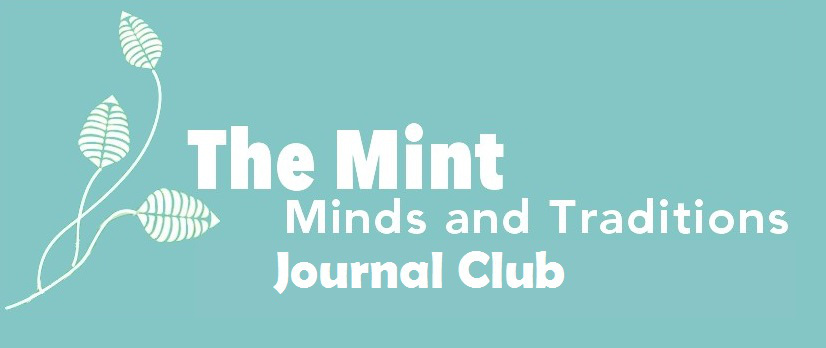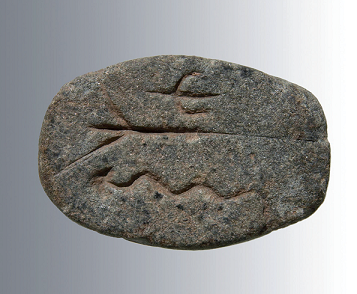Article for September: Image, Memory and Ritual: Re-viewing the Antecedents of Writing
Welcome (finally!) to the new edition of Mint Journal Club, hosted by the International Cognition and Culture Institute!
This month we agreed on reading and discussing the paper by Sarah Kielt Costello, published in Cambridge Archaeological Journal in 2011, with the title Image, Memory and Ritual: Re-viewing the Antecedents of Writing.
The article analyses the collection of Near Eastern seals and seal impressions, which developed as a system for administrative record-keeping long before the invention of writing. In the past they were catalogued by their age, finding spot, form and image, and the images were interpreted as personal or public identification symbols. How exactly and by whom they were used remains a question, because of the great variety of shapes, sizes and images they bear. The author of this article presents us with the set of images and argues that the recurring motifs with mostly cosmological subjects show that the seals were first used as tokens in a religious context and then were adopted to be used as vehicles for administrative information storage (‘memory tools’), which would support the recent view of religion being the primary motivator of people in the Neolithic and Chalcolithic times, not only environment.
Let us know your thoughts on this article!





Barbara 11 October 2016 (13:20)
I found this article very interesting, mostly as an example of an approach to images that can be found on archaeological material different to usual functional or art history perspective. The material presented here is important not only as one of the oldest examples of stamps and seals in history, but also as an important step in development of graphic imagery towards writing.
The author explains the context of the images as a transitional period of early Neolithic (New Stone Age) marked by first communities settled in permanent villages becoming first cities in the area known as Fertile Crescent. This period is marked by rapid population growth and increased social stratification, especially in emerging urban centers, which can be seen in monumental architecture, increased trade and work specialisations. First elites emerged as warriors and religious leaders, whose administrative needs led to invention of writing – a view promoted by most researchers of ancient history and early writing of Mesopotamia and Eastern Mediterranean, that mostly consists of lists of goods and trade contracts.
The author of this article argues that even if the writing is used for administrative purposes its evolution must involve complex cognitive and social issues that deserve more attention. She is searching for the meaning of the images on pre-writing stamps and tokens by looking for analogy in other contemporary Neolithic material and follows the evolutionary path of the motive in the later Mesopotamian material culture.
The objects she is looking at, seals and tokens, are seen as “memory tools”, objects storing certain information, although for the Pre-Pottery periods (c. 9500 – c. 6500 BC) no clear function is attributed to the engraved objects. The author sees the images as religious in nature, rooted in Neolithic cosmology that is depicting the man’s struggle with “the wild” in the times of early domestication, which includes the interpretation of abstract engravings as visions in state of intensified consciousness related to shamanistic practice.
The presence of religious images on “memory tools” is suggested to be due to use of memory tools in a ritual context, whereas the administrative use of the seals is explained by religious beliefs and practices of the Neolithic being “embedded in mundane activities”. The question of the fate of imagery after emergence of writing is left unanswered, but the author sees the confirmation of her theory of seals as religious memory tools in the fact that first the ritual specialists (priests) and later the temples were the ones who controlled memory storing first in religious images (“memory tools”), and later in writing performed by temple scribes.
I find the general idea of images, religious practices and memory storing very appealing and worth further research, and I find this a good attempt of balancing between functional view (the “administrative use”) and esoteric interpretations (“shamanism”) in archaeology. It would be interesting to broaden the dataset and compare it to other early writing centers (China, Central America) to test the idea of relationship between early graphic codes and cosmology inspired by emergence of agriculture and permanent settlements in those contexts as well.
Piers Kelly 12 October 2016 (06:12)
Three related claims come to the fore in Sarah Kielt Costello’s paper: a) that a continuity can be established between the visual culture of the Neolithic Near East and fourth millennium Mesopotamia when writing was first invented b) that the imagery of early seals etc is interpretable in a religious frame c) that religious rather than administrative concerns marked a transition from seal imagery to writing, contrary (or complementary) to Schmandt-Besserat’s hypothesis.
I have no trouble with the first claim given that pictorial cultures are known to have extraordinary longevity (Australia comes to mind). The second and third claims, however, are rather more ambitious.
When an ancient visual system is conserved into the contemporary era, albeit with multiple transformations along the way, we can consult its living practitioners for interpretive guidance. Likewise, in rich archeological sites it is sometimes possible to learn enough about the contexts of symbols to make confident predictions of their meanings. Rarely, however, do we get a the kind of three-dimensional view represented, for example, in H. P. Lovecraft’s novella At the mountains of madness (1936). Here a team of Antarctic explorers stumbles upon the ruins of an ancient stone city built by visiting aliens in pre-Cambrian times. The expedition leader examines the carved hieroglyphics on the walls of the buildings and finds them to be so intuitive and transparent that he is able to reconstruct the rise and fall of the entire civilisation.
“Beneath their strict conventionalisation one could grasp the minute and accurate observation and graphic skill of the artists; and indeed, the very conventions themselves served to symbolise and accentuate the real essence or vital differentiation of every object delineated. […]The subject-matter of the sculptures obviously came from the life of the vanished epoch of their creation, and contained a large proportion of evident history. It is this abnormal historic-mindedness of the primal race—a chance circumstance operating, through coincidence, miraculously in our favour—which made the carvings so awesomely informative to us.”
Given that the memory tools under examination are not quite so “awesomely informative” I find Costello’s interpretation to be interesting and logically argued, but not always convincing. She argues persuasively that the repetition and continuity of raptors and snakes is evidence for their cultural salience, and that the apparently masked human are not in domestic roles or passive stances, suggesting they are figures of otherworldly authority. However I’m less convinced by her more elaborate model of a hypothetical Neolithic world view involving a three-tiered cosmos, rituals of death and renewal embodied in animals, and soul flight, all of which are mediated by ritual specialists possibly in trance or under hallucination.
Enticing as this Jungian scenario may be, it strikes me that the exact meaning of Neolithic images is less crucial for our purposes than the system by which they are organised. In Andreas Stauder’s analysis of the U-j system at the Abydos tomb, for example, he points out that the Egypt’s pictorial culture had taken on some of the conventionalisation and systematicity that we associate with writing even before writing-proper was actually developed. Taking Stauder’s approach we might propose that the Neolithic glyptic already shows reduction to a small size and a recalibration of proportions within the artefacts themselves. In one of Costello’s illustrations we find that the snake, human figure and bird are more or less the same size relative to one another, just as we might expect from an inventory of written characters. Stauder would then be looking at compositionality and for evidence of consistent orientation, among other things. This latter is perhaps already detectable in the Sabi Ayad seal impressions where the caprine images all face the same way.
Thus Costello’s suggestion that religious elites were overtaken (or overthrown) by administrative elites is interesting but, perhaps ancillary to the question of how cuneiform emerged from a non-linguistic graphic code. After all, a successful graphic code can theoretically be developed by anyone, be they high priests, dairy farmers or bureaucrats. Once it is capable of doing the work of a memory tool—ie, notating the world with a consistent and limited set of symbols—it can more easily be transposed to a new context with a different function.
Thomas Müller 12 October 2016 (11:55)
I agree with Piers that the main issue of the paper is about the transparency of the graphic codes. It is interesting to see very iconic (pictures of reptiles, birds, humans) and very abstract (zig-zag lines, circles) carvings on these ancient artefacts, sometimes together on one artefact. Now, how can we find out about the symbolic meaning of these carvings (if there is any)?
My answer would be: by putting them into their context. Consider the schematic representations of bird, human, and snake, which are also pictured in the original post. They are iconic in the way that they still share features with the referents they represent: The snake is wiggly, the bird spreads its wings. However, at first glance and without prior knowledge, we would not have come to the meanings of “bird” and “human” at all. Thus, the carvings are located somewhere between clearly iconic and clearly abstract representations. Now, the interpretation is helped by the context provided in Costello’s paper: Similar but more iconic carvings are shown that clearly represent the respective entities. The same logic can be applied to the interpretation concerning the religious framework surrounding the carvings: The probability of underlying religious symbolism increases if they are mostly found together with other religious tools, or at sites where religion was practiced.
j_winters 16 October 2016 (20:03)
I don't really have much to add beyond what others have already mentioned. But I am genuinely curious about the account Costello's supposedly arguing against. Is it really true that others have actually argued for a 'simple, unilinear account of information storage before writing''?
I always thought the argument was subtler: that the use of objects as 'memory tools' provides a more fertile ground for the emergence of a fully-fledged writing system (it is a probabilistic argument: if you have A then you increase the probability of transitioning to B).